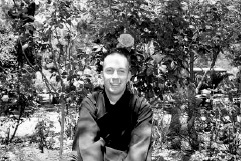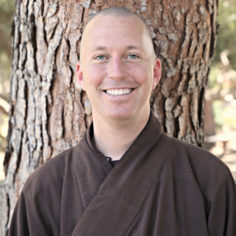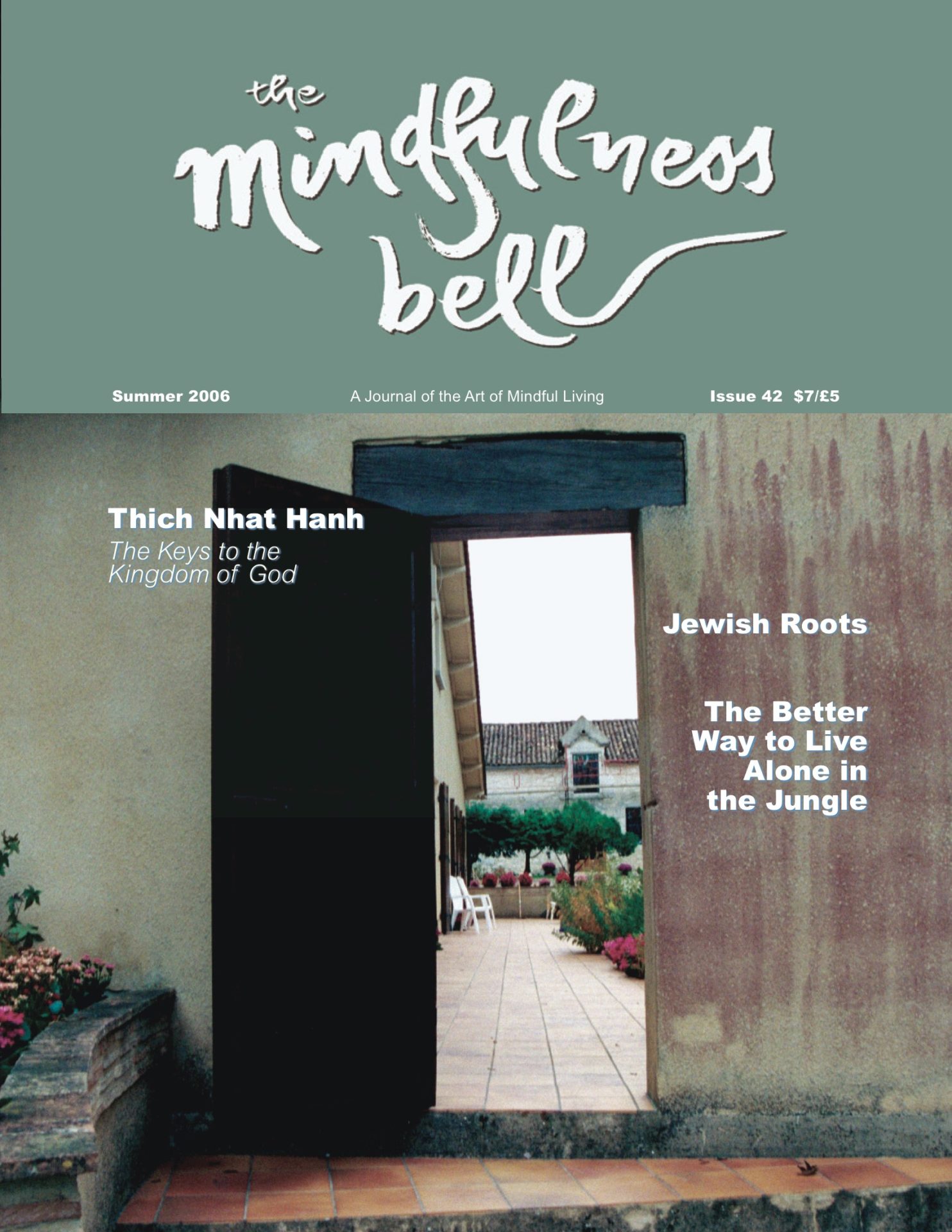By Brother Phap Hai in June 2006
This article is an excerpt from dharma talks given by Brother Phap Hai at Deer Park Monastery during 2005.
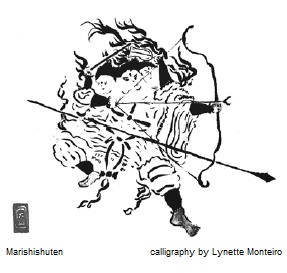
Sisters and brothers, in the Chinese language they have a beautiful way of referring to a practitioner. They call practitioners “cultivators,” Cultivators of the Way. In English we tend to use the word “practitioner,” which is not as descriptive as the word cultivator,
By Brother Phap Hai in June 2006
This article is an excerpt from dharma talks given by Brother Phap Hai at Deer Park Monastery during 2005.

Sisters and brothers, in the Chinese language they have a beautiful way of referring to a practitioner. They call practitioners “cultivators,” Cultivators of the Way. In English we tend to use the word “practitioner,” which is not as descriptive as the word cultivator, or cultivation.
Mindfulness practice is about cultivating the ground of our being, recognizing the seeds that we have in our consciousness, and creating the conditions that allow the positive seeds to come forth. It is about becoming fully who we are. Rather than being a practice of hard labor, through cultivating mindfulness we allow our innate wisdom to blossom, in its own time, in its own way.
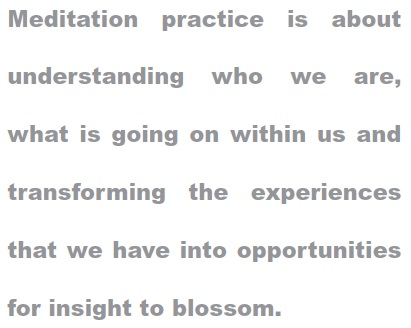
Meditation practice is about becoming a real human being, and becoming a real human being doesn’t mean that we push parts of ourselves away. It means rather that we draw parts of ourselves to us, in order to understand them.
We have a little organic garden here in Deer Park, and it’s interesting to watch how it gradually takes shape. We plant different seeds. There’s corn growing at the moment. There are tomatoes, there’s lettuce, and many other kinds of fruits and flowers growing in that organic garden. And each one of these blooms in their own time, in their own way. The corn is ripening now. It won’t ripen in winter. The tomatoes also are starting to come on now. They don’t usually ripen in December.
Nature is a wonderful teacher if we are listening. We would laugh if we walked past our organic garden in December and saw someone shouting at the tomatoes for not ripening at that time. They’re not going to grow any faster! We would feel sorry for such a person and yet we do the same thing to ourselves every day. We judge and criticize ourselves feeling that we are never quite good enough. Cultivating the ground of our being is a radical act, something that goes against many layers of conditioning, because we discover that everything that we are looking for is available right here, right now, within us. Flowers of real peace bloom when we give ourselves permission to be fully who we are.
There’s a beautiful poem by a Zen poet called Basho that sums this up perfectly:
Sitting quietly Doing nothing Spring comes and the grass grows by itself.
King Arthur and the Knights of the Round Table
In our Western tradition there’s a legend that’s coming up in popular culture right now—the legend of the Holy Grail. This myth is very deep in the Western consciousness; it just keeps coming up in different forms. Recently I listened to a lecture by Joseph Campbell on the Holy Grail called “The Forest Adventurous.” This teaching has something to say to us as practitioners.
King Arthur and the Knights are all sitting there at the Round Table. King Arthur stands up and says, “Okay! Before we eat our meal, who’s had an adventure this morning?”
(It seems that they had many more adventures in those days than we do now.)
None of the Knights of the Round Table had anything to share. They all just sat there.
So King Arthur said, “Well, until we have an adventure, we can’t sit down to our meal.”
They’re all thinking, now what kind of adventure could we have? What are we going to do so we can eat? And then the Holy Grail appears, beckoning them on a quest. They decide, all right then, we’re going to set out in search of the Holy Grail. They get onto their valiant steeds and tsch-tsch-tsch-tsch plod down to a forest, conveniently nearby, which just happens to be called the Forest of Adventure.
Interestingly, in this story of the Holy Grail, although you set out on a quest—you know, these valiant quests, with a big horse, a big sword, and everything—you do not find the Grail, it finds you. Here we have the same teaching as Master Linji, to stop our seeking, to stop running around, and come back to what is going on right here, because the path, the Holy Grail, the Forest of Adventure, is right underneath our feet. What is important is our willingness to undertake this journey, the journey of opening the heart.
So they arrive at the outskirts of the forest, where they realize that there are two possibilities. Either they all enter the forest together, in search of the Holy Grail, or they enter the forest separately. Bear in mind that up to this point they had traveled together to get to the Forest of Adventure, as a Sangha, as a community. When they got to the Forest of Adventure, they felt, oh, it would be a shame for us all to go down that very clear path through the forest, but rather each Knight should enter at a place of his own choosing. Only then would it be an adventure.
In our journey of practice, initially we are in search of something— peace, enlightenment, joy, a chocolate donut—that we think exists outside of ourself. We are carried by the energy of the Sangha. For the real adventure to begin, we need to discover and nourish our own aspiration. What is your Holy Grail? Why are you a practitioner? What brings you back to your Sangha each week?
To see this, to touch this very deep and profound longing in your heart is to touch your deepest aspiration. The Sangha is a place where we help each other to realize our deepest aspiration.
The Sutra on Fear and Dread
Many of the world’s myths and legends feature this image of the forest. In European fairy tales, to give just one example, we have Hansel and Gretel going into the forest to the witch’s house. In the spiritual traditions as well we have this image of this forest, this place of the unknown. In Buddhism, what happened to Siddhartha when he decided to leave home? Where did he go? He went into the forest.
There is a series of lovely teachings about Siddhartha, the future Buddha, entering the forest. When Siddhartha entered the wilderness, he experienced great fear and dread. Any little sound in the forest, like a stick cracking, he would imagine to be a tiger coming to eat him up.
In one sutra, called “Fear and Dread,” he shares his experience of entering the forest, this place of mystery. I invite you to enjoy this discourse in its entirety, as it has much to say to us. The Buddha shares about the intense fear and dread that overcame him when he entered the forest, the place of the unknown. Leaving behind the comfortable and familiar, he shares his practice of understanding fear. When the fear and dread came upon him he would continue doing whatever it was he was doing—sitting, lying, standing—until he understood where the fear was coming from.
Once we have a solid place of refuge within us, we need to stay with what is happening, not run away, not try to distract ourselves. We in the West have a great tendency to do this—anything to avoid what we’re calling here fear and dread. It might be our sadness, our depression. The Buddha is telling us to dwell with what is being brought up for us. Meditation practice is about understanding who we are, what is going on within us and transforming the experiences that we have into opportunities for insight to blossom.
Where is the Holy Grail? Where is the Forest of Adventure, for us as practitioners, for us as cultivators? Where is the place where we feel fear and dread the most? Where is the place of mystery? It’s within our heart. Meditation practice by its very nature brings us back to what’s going on within our body, within our mind. Mindfulness practice is about learning to dwell with whatever is present.
The Sutra on Inscriptions
There is a beautiful teaching on this called “Inscriptions” :
“Monks, there are these three types of individuals to be found existing in the world. Which three? An individual like an inscription in rock, an individual like an inscription in soil, and an individual like an inscription in water.
“And how is an individual like an inscription in rock? There is the case where a certain individual is often angered, and his anger stays with him a long time. Just as an inscription in rock is not quickly effaced by wind or water and lasts a long time, in the same way a certain individual is often angered, and his anger stays with him a long time. This is called an individual like an inscription in rock.
“And how is an individual like an inscription in soil? There is the case where a certain individual is often angered, but his anger doesn’t stay with him a long time. Just as an inscription in soil is quickly effaced by wind or water and doesn’t last a long time, in the same way a certain individual is often angered, but his anger doesn’t stay with him a long time. This is called an individual like an inscription in soil.
“And how is an individual like an inscription in water? There is the case where a certain individual—when spoken to roughly, spoken to harshly, spoken to in an unpleasing way—is nevertheless congenial, companionable, and courteous. Just as an inscription in water immediately disappears and doesn’t last a long time, in the same way a certain individual—when spoken to roughly, spoken to harshly, spoken to in an unpleasing way—is nevertheless congenial, companionable, and courteous. This is called an individual like an inscription in water.
“These are the three types of individuals to be found existing in the world.”
I would add that we can be all three; in certain situations we are like water, or like soil, or rock. It depends on our conditioning.
The Four Practices for Dealing with Strong Emotion
The first practice, and perhaps the most difficult, when we’re dealing with a strong emotion—whether it’s happiness, anger, joy, hatred, sadness, jealousy—is to recognize it. We recognize what we have within our being. This is only possible if we’ve really practiced stopping, coming back to what’s going on in the present moment. As mindfulness develops, we see more clearly which experiences stimulate which seeds—joy, anger, jealousy. But mindfulness is not a practice of avoidance! It is essential to have a solid foundation, a solid place of refuge within us, but this doesn’t mean that we cut ourselves off from life. On the contrary, we begin to engage more fully in our lives.
If we’ve been able to practice stopping and coming back to ourselves, to understand a little bit more of what nourishes us and also what doesn’t nourish us, then we’re able to be open to what is happening. This is the second step: accepting.
The third aspect is embracing. Last week we had a family retreat, and I had the opportunity to see how parents embrace their children. Children are wonderful Zen masters, but they’re not always quiet, calm people sitting on cushions. They’re very active Zen masters, and sometimes very loud. I was watching how the parents were interacting with their children, how they embraced them. It was a beautiful thing to see.
Whatever seed is manifesting, we recognize it, we accept it, and we hold it. If it’s a seed of anger, a seed of resentment, we allow it to be there. We don’t push it away. We want to understand. So we hold it close to ourselves, not with the idea that we need to fix something but rather to be available for wisdom.
Recently I have not been well; I’ve had a number of health challenges. Sometimes it’s a little bit like swimming through blackstrap molasses. I have to use my energy skillfully and really choose what is important. This has been a profound teaching for me. I was given a very stark choice: the doctor could prescribe heavy medication which would mask the symptoms, or I could continue to experience the pain and take a natural route, slowly coming more in contact with the rhythms of my own body and learning what it needed. I chose to go the natural route, and I have had to accept my limitations—being weak, asking for support, being vulnerable. These things were the very hardest things for me; so my body has become a teacher.
The fourth aspect is looking deeply. When a strong emotion of misperception has arisen, and we have practiced recognizing, accepting, and embracing, then we can practice looking deeply in order to understand. What watered that seed of anger in me? What need is that anger trying to tell me about? And then we have the insight. We begin to know, when that seed of anger arises in us, how to work with it. And very slowly, very gently, the seed of anger changes. The way it manifests begins to change, and it transforms from something that we used to see as entirely negative into something positive.
Creating Happiness
Our ability to create happiness within and around ourselves depends very much on our ability to be available to those conditions that we have in our heart, in our life. We need to transform those seeds that ordinarily we think are negative. In fact, our anger can be something very positive. It’s not that we want to water the seed of anger, but when the seed of anger arises, we begin to practice these things—to recognize it when it arises, to accept it, to embrace it, and then to start looking deeply.
We need to be really honest with ourselves. When we can embrace with attention the seeds that we call negative, then understanding will grow. I always like to say that the seeds that we think are negative are really just the positive seeds in disguise. With mindfulness practice we will see this.
We know, for example, what things touch the seed of anger within us. We know what things touch the seed of joy within us. So we cultivate the ground of our being for this transformation to take place. We begin to understand how to nourish the positive and healing elements within us, in the search for this Holy Grail—the Holy Grail of understanding, the freedom of the heart.
1 “Fear and Dread” Bhaya-bherava Sutta, Majjima Nikaya 4 2 “Inscriptions” Lekha Sutta, Anguttara Nikaya III.130
Thay Phap Hai is Australian by birth and is entering his tenth year of monastic life. He was ordained as a Dharma Teacher in January 2003.
